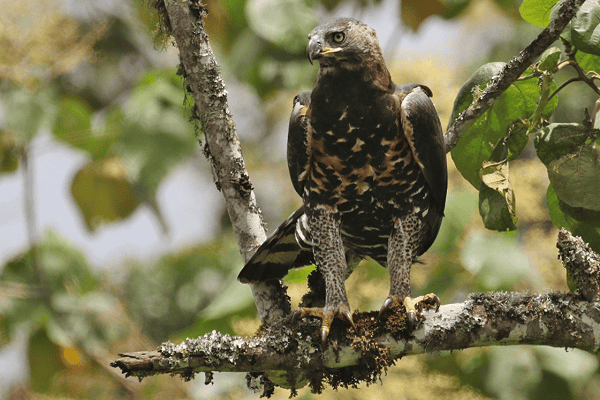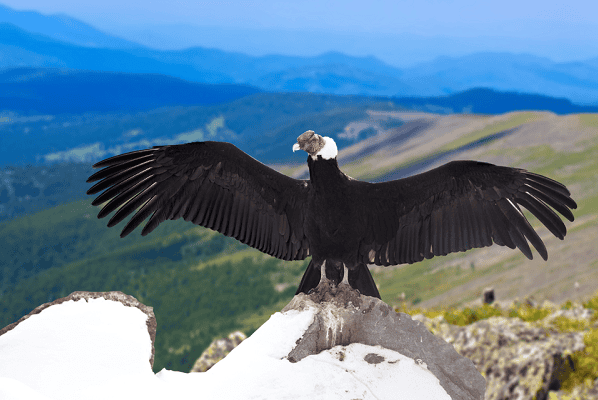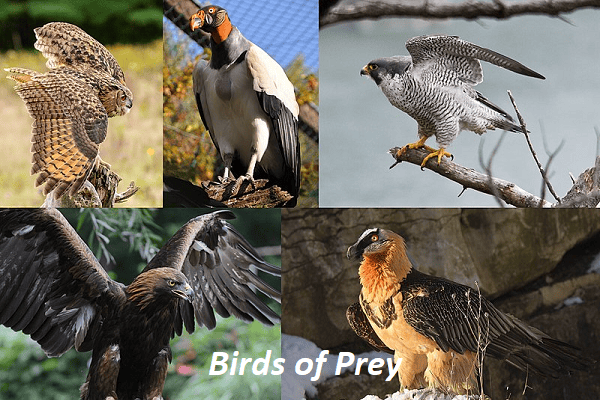Birds of prey, also known as raptors, are really cool animals that are super strong and have awesome abilities. They’re like the bosses of the food chain! So, to show off some of the biggest and mightiest raptors ever, we made a list of ten of them.
But wait, before we dive in, let’s make it clear that we’re counting condors and vultures too. Even though some experts argue whether they’re true birds of prey, we’re including them because they act a lot like raptors. So, get ready to be blown away by these massive birds of prey.
Here we’ll learn about 10 different types of Largest Birds of Prey
1. EURASIAN EAGLE OWL

The Eurasian Eagle Owl lives in the mountains and forests of Europe and Asia. It’s a big bird, weighing about 4.2 kilograms (9.2 pounds) and has a wingspan of around 2 meters (6.5 feet). This owl is one of the biggest and strongest in the world. While there are many owls its size, the Eurasian Eagle Owl stands out because it’s the only owl known to have killed a human. But don’t worry too much, it mainly eats rodents, feeder rabbits, and small foxes.
2. MARTIAL EAGLE

The Martial Eagle, Africa’s largest eagle, boasts an impressive wingspan measuring 2.6 meters (8.5 feet) and can weigh up to 6.2 kgs (13.6 lbs.). Its sheer size and powerful talons make it a formidable predator in the African skies. However, this majestic bird occasionally poses a threat to farmers’ livelihoods by attacking their livestock. As a result, many farmers find themselves in a dilemma, torn between admiration for the eagle’s magnificence and the need to protect their animals. Some even resort to drastic measures to eliminate this bird of prey, seeking a delicate balance between coexistence and safeguarding their livelihoods.
3. PHILIPPINE EAGLE

The Philippine Eagle is such an amazing bird that it’s a symbol of pride for the Philippines. It’s adapted to hunt in forests and despite being quite heavy, weighing around 7 kilograms (15.3 pounds) and having a wingspan of 2 meters (6.5 feet), it’s super agile. This eagle eats a variety of animals like monkeys, large bats, lemurs, pigs, and even dogs.
4. STELLER’S SEA EAGLE
Steller’s Sea Eagle (scientific name: Haliaeetus pelagicus), also known as the Pacific sea eagle or white-shouldered eagle, is a very large diurnal bird of prey in the family Accipitridae. It was first described by the Prussian naturalist Peter Simon Pallas in 1811. No subspecies are recognized for this majestic eagle.

With its dark brown plumage, white wings, and tail, the Steller’s Sea Eagle is striking in appearance. Its yellow beak and talons add to its formidable presence. Typically, it holds the title of being the heaviest eagle in the world, weighing approximately 5 to 10 kg (11 to 22 lb). However, in some standard measurements, it may rank below the harpy eagle (Harpia harpyja) and the Philippine eagle (Pithecophaga jefferyi).
Size and Range:
- Wingspan: Up to 8 feet
- Habitat: The Steller’s Sea Eagle is endemic to coastal northeastern Asia, where it inhabits regions in Russia, Korea, Japan, China, and Taiwan.
- Notable Population: The Kamchatka Peninsula in Far Eastern Russia is home to a relatively large population of these eagles, with approximately 4,000 individuals residing there.
Diet and Behavior:
- The Steller’s Sea Eagle primarily preys on fish and water birds. In its breeding grounds, it subsists largely on salmon, which appear en masse in coastal areas and rivers.
- These birds of prey are skilled hunters, diving from perches or in flight to clutch prey in their talons. They also stand in shallow water or on ice, seizing passing fish.
- Interestingly, they are known to attack other large birds and even baby seals.
Conservation Status:
- Unfortunately, despite its impressive size and strength, the Steller’s Sea Eagle is labeled as a vulnerable species on the International Union for Conservation of Nature’s Red List (IUCN Red List).
- One of the significant threats to their survival is lead poisoning. They ingest lead while scavenging on animal remains left by human hunters.
- Efforts are underway to protect and conserve these magnificent eagles, especially in regions where they are revered, such as Japan, where they are known as “O-washi”
5. HARPY EAGLES

Harpy Eagles are the strongest eagles out there, weighing a whopping 9 kilograms (19.8 pounds) and boasting a wingspan of 2 meters (6.5 feet). Despite their size, their wings aren’t as wide as other big birds since they need to zip through dense forests. These raptors have super long talons and a grip so powerful it could break a person’s arm! They mostly hunt sloths, monkeys, and big birds.
6. AFRICAN CROWNED EAGLE
The African Crowned Eagle (Stephanoaetus coronatus) is a formidable and majestic raptor that inhabits the lush rainforests of tropical Africa. Let’s delve into its remarkable features and hunting prowess:

Physical Characteristics:
- Wingspan: Despite having a relatively modest wingspan of 2 meters (6.5 feet), the African Crowned Eagle compensates with sheer power and agility.
- Weight: This bird of prey is not to be underestimated. It can hunt animals weighing up to an impressive 35 kgs (77.1 lbs.).
- Talons: The eagle’s talons are its most fearsome weapon. They are exceptionally strong and sharp, allowing it to grasp and immobilize its prey with deadly precision.
Hunting Behavior:
- Monkeys and More: The African Crowned Eagle is an opportunistic predator. While it primarily targets Guinea fowl, it doesn’t shy away from larger prey. It has been observed hunting monkeys, including those with substantial body mass.
- Skull-Crushing Talons: The eagle’s talons are not only for show. They are capable of exerting immense pressure, and in some cases, they can crush the skulls of monkeys during their lethal strikes.
- Varied Diet: Beyond monkeys, the Crowned Eagle also preys on a diverse range of animals, including hyraxes, agwantibos, chevrotains, and small antelope. Its adaptability allows it to thrive in the complex ecosystems of the rainforest.
7. BEARDED VULTURE

The Bearded Vulture, also known as the Lammergeyer, is a bird of prey that commands the skies with its massive size and distinctive behavior. Weighing up to 8 kgs (17.7 lbs.) and boasting a wingspan that stretches over 3 meters (9.8 feet), it is one of the largest raptors in the world. Found across high-altitude landscapes in Asia, Europe, and Africa, the Bearded Vulture has adapted to a life amidst rugged terrains. Unlike many other birds of prey, it is primarily a scavenger, known for its unique method of feeding. It soars to great heights with dead animal carcasses, only to drop them onto hard surfaces below.
Also read: White Birds in Florida
8. CALIFORNIA CONDOR

The California Condor, recognized as North America’s largest bird, boasts a remarkable wingspan stretching three meters (9.8 feet) and can tip the scales at a hefty 12 kilograms (26.6 pounds). This majestic avian species commands attention not only for its sheer size but also for its crucial ecological role. Revered by indigenous cultures and modern conservationists alike, the condor’s diet revolves primarily around carrion, making it a vital component of nature’s cleanup crew. Feasting on a range of carcasses from deer and cattle to smaller prey like rabbits and rodents, these scavengers play a pivotal role in maintaining the delicate balance of ecosystems across their habitat.
9. LAPPET-FACED VULTURES

Lappet-faced vultures are huge, about the same size as American Condors, with a wingspan reaching 3 meters (9.8 feet) and weighing up to 14 kilograms (30.8 pounds). You can find them in African savannahs and in Arabia. These birds of prey often hunt down gazelles, antelopes, and even flamingos. They’re not shy about raiding nests either, snatching eggs and young birds. They’re so fierce that they’ll even go after other predators to protect their meal of carrion.
10. ANDEAN CONDOR

The Andean Condor, a majestic and endangered species, holds the title of the largest bird of prey, boasting an impressive wingspan spanning three meters (9.8 feet) and weighing in at a formidable 15 kilograms (33.1 pounds). Thriving in the rugged terrain of mountainous regions, these magnificent creatures rely on the updrafts of wind that sweep through their habitat to effortlessly navigate the skies. With their vast wingspan and aerodynamic prowess, Andean Condors are perfectly adapted to harness the power of these winds, enabling their massive bodies to soar gracefully across the peaks and valleys they call home.
Must Visit: Hummingbirds in Michigan





Add comment